Introduction
Medicinal plants have played an important role in the conservation of human health, but these species are still collected mainly in the natural area, so many of these plants have become extinct or threatened by genetic erosion (Ming, 2012). This process is a consequence of lack of scientific information about the reproduction, propagation and, especially, about the cultivation of these medicinal species, since most extractivists and producers do not know the care that must be taken in the several stages of obtaining this type of raw material (Zaroni et al., 2004).
As a result of predatory exploitation, in 1992, the jaborandi (Pilocarpus microphyllus Stapf ex. Wardl) was included on the Official List of Brazilian Flora Species Threatened by Extinction, through the Ordinance No. 37-N, dated April 3th, 1992 (Silva et al., 2001, p. 44). In the State of Pará, the species can be found in larger quantities in the Serra do Carajás, where the species is exploited by a extractivist group and for this reason there are good data about its distribution in this Conservation Unit (Martins, 2015, p. 75).
Jaborandi is a plant species of paramount importance for the pharmaceutical industry (Lima et al., 2015). It contains several alkaloids, including pilocarpine, which is used in the pharmacological industry to produce medicament for the treatment of glaucoma, a serious eye disease (Nordstrom et al., 2005).
The leaf of the jaborandi is the plant part of economic interest, from which the pilocarpine is extracted, therefore, leaf production is the main variable that determines the productivity of this species (Grabher, 2015, p. 297). Jaborandi leaf production can be managed by pruning the branches in its development phase.
According to Thomaziello and Pereira (2008), p. 39, pruning is the operation which has the main purpose of eliminating plant parts that, during the cycles, have lost or decreased their productive capacity, whose natural recovery possibility is practically nil. Through pruning, the apical dominance is suppressed as a consequence of altered hormonal balance, thus stimulating the shoot emission and development from lateral buds (Pedro, 2011, p. 37).
Based on the arguments presented and the need for strategies that support jaborandi conservation and management, the objective of the present study was to evaluate the regeneration of jaborandi branches submitted to two types of cuts and differents cropping systems.
Materials and methods
The jaborandi specimens used in this study belong to the Jaborandi Active Germplasm Bank (BGA) located in the Horto de Plantas Medicinais/ Embrapa Amazônia Oriental in the municipality of Belém, Pará (latitude 1° 27’ 21 S; longitude 48° 30'14‘’ W), at 10 meters’ altitude and 30 °C mean annual temperature. During the experiments, the plants were 6 years old.
Experiment I
In the first experiment, prunings were carried out on jaborandi plants cultivated under two cropping systems: full sun and shade. These plants belonged to the Merck accession from the municipality of Barra do Corda, Maranháo, Brazil.
With pruning shears, cuts were made at 10 and 20 cm from the branch bifurcations in jaborandi plants 0.50 to 2 meters tall. The cut sites were identified by different colored tapes (Figure 1).
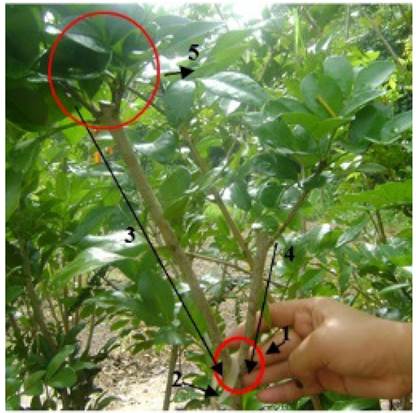
Figure 1 First pruning. 1.circle showing the bifurcation; 2. tape used for plant identification; 3. cut at 20 cm from the bifurcation; 4. cut at 10 cm from bifurcation; 5. shoots from pruning.
After pruning, the plants were evaluated every 30 days, and the parameters analyzed were: number of leaves per shoot and length of the biggest shoot.
The experimental design was a 2x2 factorial, involving two cut distances (10 and 20 cm), and two cropping systems (full sun and shade), with five replications, each consisting of one plant. Eight cuts (four of 10 cm and four of 20 cm) were made on each plant, in both cropping systems, totaling 80 cuts.
Experiment II
In the second experiment, prunings were performed on jaborandi plants, cultivated under full sun. These plants belong to the Japanês and Bonal 4 accessions (from the municipality of Mojú, Pará, Brazil) and the Merck accession (from municipality of Barra do Corda, Maranhão, Brazil). The cut system and the paramenters analyzed were the same as in experiment I.
The experimental design was a 2x3 factorial, involving two cut distances (10 and 20 cm) from the bifurcations, and three accessions (Japanês and Bonal 4, and Merck) cultivated at full sun, with five replications consisting of one plant. Eight cuts (four of 10 and four of 20 cm) were made on each plant, in the three accessions, totaling 120 cuts.
Experiment III
In this experiment, subsequent prunings were performed on jaborandi plants from the Japanês accession cultivated at full sun. With pruning shears, cuts at 10 and 20 cm of distance from the branches bifurcations were made on plants 0.50 to 2 meters tall.
After the pruned branches had regenerated, pruning was performed again, this time only at 20 cm from the branch bifurcations that had regenerated. The parameters evaluated were the total number of shoots, total number of leaves per shoot, length of the biggest shoot, number of leaves of the biggest shoot, and regeneration time.
A randomized complete block design was used, represented by two prunings: initial pruning and after regeneration; and by the Japanês accession, cultivated at full sun, consisting of five plants and eight cuts (four of 10 and four of 20 cm) on each plant, totaling 80 cuts.
Experiment IV
In this experiment, the Merck accession, cultivated at full sun, was used. The leaves were harvested with pruning shears, using the drastic pruning technique. Pruning was performed in the east and west directions, according to the plant layout in the area. The cuts were made at 20 cm from the branch bifurcations of 0.50 to 2 meters tall plants, which were recorded, identified and evaluated every 10 days during the period from February to October, 2012. The parameters were the total number of shoots, total number of leaves per shoot, length of the biggest shoot, and number of leaves of the biggest shoot.
A randomized complete block design was used, represented by cuts at two orientations, east and west, and by the Merck accession, cultivated at full sun. Five plants were pruned and 10 cuts were made on each one in the east and west directions, totaling 100 cuts.
The evaluations were carried out at five, ten and fifteen months for Experiment I and five months for Experiments II, III and IV. The data obtained were statistically interpreted by analysis of variance and the means compared by the Tukey test (P < 0.05) using the Sisvar program.
Results
Experiment I
At five months after pruning there were no statistical differences for the parameters evaluated at both cutting (heights) distances (10 and 20 cm), as well as the number of leaves considering the cropping system (full sun and shade). However, there was a difference among the cropping systems for the shoot length of the branches. The plants cultivated under full sun obtained the highest means value (20.3 cm) at the 10 cm cut while the plants cultivated in the shade, at the same cutting height, had a lower mean length (3.15 cm) (Table 1).
Table 1 Means of number of Leaves and the largest shoot Length of the branches in jaborandi plants, from the Merck accession.
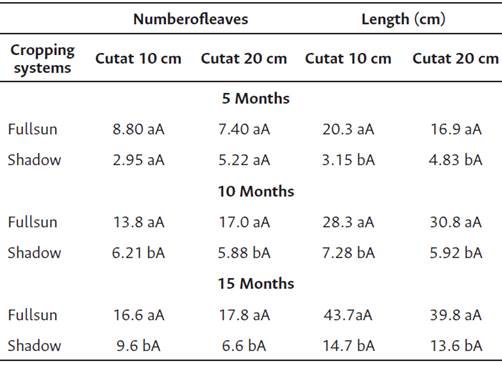
*Means followed by different lowercase letters vertically and different upper case letters horizontally, differ at the 5 % probability level by the Tukey test.
At ten months after pruning, no statistical difference was observed between the cut distances. However, there was a difference among the cropping systems, especially the plants cultivated in full sun, which presented the highest mean number of leaves (17.0) and the highest mean shoot length (30.8 cm).
At 15 months after pruning, there was no significant difference between the cut distances. However, a significant difference was observed among the cropping systems and the full sun system was better for both parameters evaluated. The highest mean leaf number (17.8) and the highest mean length (43.7 cm) of the biggest shootwere recorded at 20 and 10 cm cut distance, respectively, from the branch bifurcation.
Figures 2 and 3 show the evolution on branch regeneration of jaborandi in number of leaves and length (cm) of Merck Access cultivated under full sun, which was more efficient than Merck access cultivated in the shade. With an appropriate pruning management, performed during one year, it was obtained an increasing regeneration of the branches. In this way, a good amount of fresh plant was obtained to prepare the vegetal extract. For example, the cut at 20 cm obtained an initial mean of five leaves per branch, and after one year and two months this branch presented a mean of 31 leaves. The 10 cm cut also presented the same tendency, with an initial mean of five leaves and 28 in the end (Figure 2).
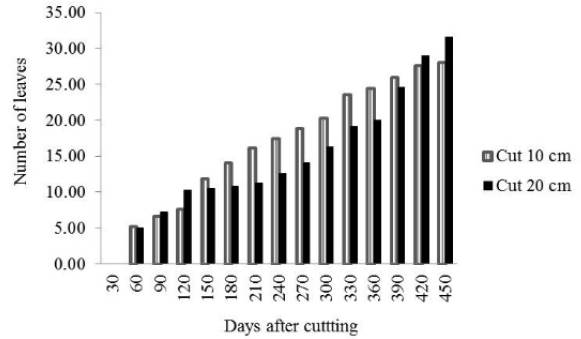
Figure 2 Means of leaf number of jaborandi branches regeneration, belonging to Merck accession cultivated under full sun, 450 days after cutting.
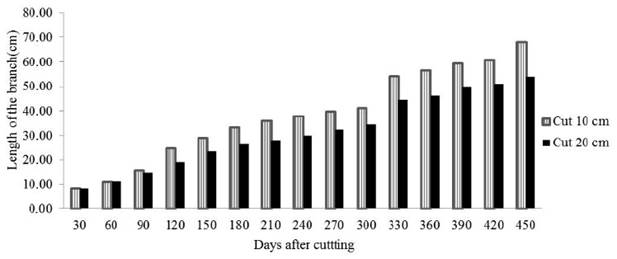
Figure 3 Means of the length (cm) of jaborandi branches regeneration, belonging to Merck accession cultivated under full sun, 450 days after cutting.
The length of the branch followed the leaves’ growth, with a progressive increase over the months, regardless the type of cut, having an initial mean growth of 8.23 cm and 8.24, and 53.8 cm, 53.8 in the end of the evaluation, at 20 cm and 10 cm cut, respectively (Figure 4).
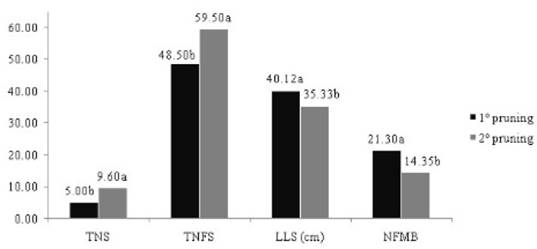
Figure 4. Parameters evaluated in shoot development in jaborandi branches from the Japonês accession. Total number of shoots (TNS), total number of leaves per shoot (TNFS), length of the largest shoot (LLS) and number of leaves of the biggest shoot (NLLS). *Means followed by lowercase letters differ from each other at 5 % probability level by Tukey test.
Experiment II.
Table 2 shows a performance comparison between the Merck, Bonal 4, and Japanês accessions in the evaluation carried out five months after pruning.
Table 2 Mean of number of Leaves and Length of the biggest shoot of branches in jaborandi plants, submitted to different cut distances in the Merck, Bonal 4, and Japones accessions, 5 months, after cutting.
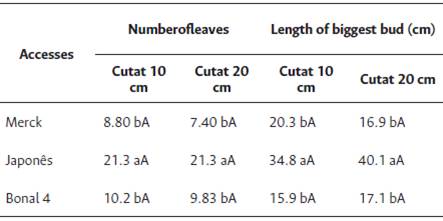
*Means followed by different Lowercase Letters different vertically and different upper case Letters horizontally, differ at the 5 % probability level by the Tukey test
There was no significant difference between the cutting distances. However, there was a significant difference between the accessions for mean number of leaves and mean length of the biggest shoot. The highest mean number of leaves was obtained in the Japanês accession (21.3 cm) at 10 cm cut from the branch bifurcation, and the biggest mean length of the biggest shoot with 40.1 cm at 20 cm from the bifurcation. There were no significant differences between the Merck and Bonal 4 accessions in either parameter evaluated.
Experiment III
Figure 4 shows shoot development on jaborandi branches in the Japanês accession, after consecutive pruning. In the first cut, the highest mean number of leaves (21.3 leaves) and length of the largest shoot (40.1 cm) were observed.
The highest mean number of shoots and total number of leaves per shoot was obtained in the second pruning, with 9.60 shoots and 59.5 leaves. The time to appearence the first shoot, after the first and second pruning, regardless of the cutting distances, was approximately 16 days.
Experíment IV
The mean number of shoots, total number of leaves per shoot, length, and number of leaves of the biggest shoot, under the influence of the east and west pruning directions are presented in Figure 5.
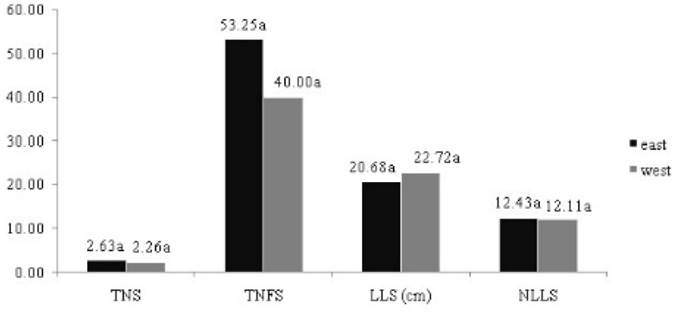
Figure 5. Parameters evaluated in shoot development in jaborandi branches after drastic pruning. Total number of shoots (TNS), total number of leaves per shoot (TNFS), length of largest shoot (LLS), and number of leaves of the biggest shoot (NLLS).*Means followed by lowercase letters differ from each other at 5 % probability level by Tukey test.
There was no significant difference between the east and west pruning directions for the parameters evaluated in the determined period. However, numerically, there was considerable regeneration of the bush, average of 3 shoots and 12 leaves on the largest shoot for both directions. The biggest mean number of leaves was 53.2 for east direction and 22 cm for the length of largest shoot.
Discussion
The results showed that from 10th month after branch pruning, the cropping full sun system and the cut made at 20 cm distance responded with greater efficiency, also allowing that new cuts could be carried out, successively, without damage to plant development. These results must be directly related with the biggest number of leaves that remains in the branch for photosynthesis. Thus, having a greater number of leaves, we will also have a greater content of chlorophylls and carotenoids and these two components are directly linked to the photosynthetic efficiency of plants and, consequently, to their growth and their adaptation to different environments and types of stress, as happened with the pruning performed in this work (Poudel et al., 2008).
Moreno-Medina et al. (2016) obtained similar results in a study carried out with differents height of cutting in Rubus alpinus Macfad, showing greater branch regeneration and a biggest amount of leaves at the longer cut. This was observed in this study when the pruning was performed at 20 cm. Also, according to Chibinga et al. (2016) if the plant is cut in a bigger height, causing less stress, because fewer material is removed, it will be more exposed to the light and therefore will generate more shoots.
Considering that the leaves are the commercial part of the jaborandi plant, this regeneration took less time than expected by the “leaf collectors” in the municipality of Parauapebas, Pará, Brazil, who leave the plant to rest for approximately one year before carrying out the next harvest (Homma, 2014, p. 467).
In Maranhão State the extractive system occurs during the dry season (July to December), and the jaborandi collectors leave these plants to rest during the rainy season. However, excessive and frequent leaf collection from the same plant or group of plants does not allow the complete development of new leaves, causing a high mortality percentage and a considerable reduction in plant height and vigor, as well as reduction in the size of re-sprouted new leaves (Pinheiro, 2002).
Islam et al. (2008), also observed that the pruning results in a quick growth and development of young shoots, indicating that this practice is commercially useful to the farmers of Bangladesh for fodder, fuel and manure production of Sesbania grandiflora L.
According to Weiss et al. (2011), p.40 an important rule is the shrub’s pruning shape: instead plucking the plant, the collectors should prune it, considering the plant characteristics and in addition, the pruning should be done with appropriate pruning shears, so as not to damage the shrub and enable its growth.
Moura et al. (2016) mention that pruning is a technique used for several crops, and the plants present different degrees of tolerance to this management. In this study it was observed that a pruning management for jaborandi is possible, which presents a positive effect on branch regeneration.
It was observed that, after pruning the branches with pruning shears, regardless of the cut distance, new branches sprouted with no damage to the plants, contrary to that observed when the leaves are harvested drastically and totally by the collectors in the Serra do Carajás, Pará, Brazil. According to Homma (2014), the “pruning” system must be performed with shears so that leaves and residual branches remain to help in the plants recovery.
Konig Brun et al. (2007) explain that this negative relationship between new leaf phenophasis and pruning may be due to the mechanical damage generated during the execution of this practice, which, when done improperly, instead of serving as “renovation” to the plant, generates high physiological stress, so that the plant moves its reserves to form cicatricial callus instead of foliage. On the other hand, Mendonça et al. (2016) also report that canopy management according to the pruning type and intensity will have an effect on the next production cycle, due to its impact on accumulated reserves and buds.
In a study about conduction pruning with Ficus carica L., Oliveira Silva et al. (2017) observed that the plants had a favorable cycle production after the pruning, obtaining uniformity in the growth of the branch and broad leaves. In this study, jaborandi plants presented a great growth of the branches and an appropriate leaves regeneration, after the pruning.
Renovation canopy pruning should be considered when the aim is to remake part of the canopy, but without altering the plant’s main architecture. According to Scarpare et al. (2011), p. 54, drastic pruning should be considered when part of the plant’s main architecture, such as the trunk and primary branches, are cut for the purpose to be reformed and renovated. In this study, the jaborandi responded positively to this type of pruning, enabling the consecutive vegetal drug harvest without any damage to the shrub.
Correa de Moura et al. (2017) performed differents types of pruning in mirtilo plants (Vaccinium spp.), the plants that receive drastic pruning presented bigger regeneration, fruits production and bigger concentrations of phytochemical compounds. It means that differents pruning intensities can modify the branches regeneration and the productivity of leaves and fruits. These results agree with the study performed with jaborandi, when the plant had a positive branch regeneration and leaves compared to drastic pruning.
Based on the data presented, and if the collectors harvested the leaves correctly by pruning and without damaging the plants, the jaborandi would be benefited, getting new shoots on the branches, which could anticipate the harvest and increase it without damage to the plant development.
Conclusions
The pruning benefited the launching of new shoots, regardless of the distance and direction of cultivation, east and west. With the growth of new shoots, the harvest could be anticipated without harming the plant’s development.
The drastic pruning performed on the species also provided an efficient regeneration, without damaging the plant, resulting in greater leaf production, regardless of the cultivation direction, east and west.
It was also observed that the cultivation of jaborandi becomes more productive when cultivated in full sun and the regeneration of new shoots directly depends on the type of access you are working with.














